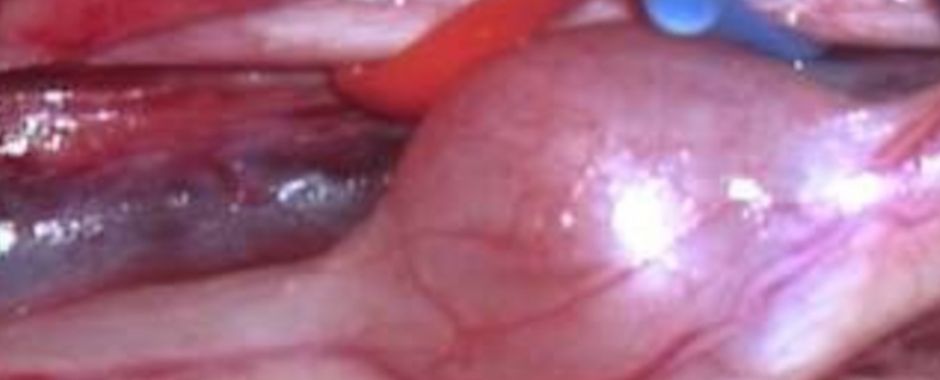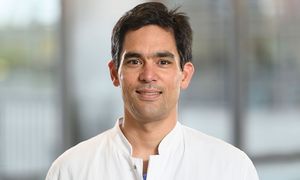
Pain in genetic neuropathies

Neurofibromatosis
Some neuropathies develop in relation to genetic diseases. In the various forms and manifestations of neurofibromatosis, more or less severe tumourous growths occur in the central and peripheral nervous system. The nodule-like formations occur along cranial, spinal and peripheral nerves and can damage them by increasing pressure. Neuropathies with functional nerve compromise are caused by both, tumour pressure and by mechanisms that are not yet precisely known. These manifest in sensory and motor disturbances with paraesthesia, paralysis and sometimes very severe pain, which resolves in some patients but not in others.
Research Objective
How such painful neuropathies differ in the various types of neurofibromatosis and why pain resolves in only some of affected persons are the major research targets in Project 2 of the KFO5001supported by the German Research Council. As part of long term studies, the results from imaging by innovative methods of MR nerve and ganglia imaging as well as clinical, electrophysiological and molecular investigations will be stored to form the KFO database and biobank. Potentially identified clinical or molecular biomarkers of pain resolution will be investigated in relation to structural properties, pathophysiology, and nerve excitability.
Approach
After in depth characterization of the type of neurofibromatosis and phenotypic manifestation, nerve imaging will be performed by neuro-sonography and MR neurography, and patients’spinal ganglia will be investigated by functional MRI and compared to the pain cohort of the KFO 5001, including patients with complex regional pain syndromes (CRPS), chemotherapy related polyneuropathies and chronic postoperative groin pain. Electrophysiological and molecular investigations are performed for skin, tumour and nerve samples. In selected patients, skin biopsies will be used for the individual production of human induced pluripotent stem cells (hiPSCs). These will be the base to generate neurons, one major goal of the cooperative Project Z.
Biopsies of pathologically altered nerves
In selected patients, pathologically altered nerves are harvested by circumscribed microsurgical nerve fascicle biopsy, and will be investigated for the properties of the blood-nerve barrier, highly important for pain conduction. In addition, via transcriptome analysis, a qualitative differentiation of RNA and thus protein synthesis will be provided. The primary focus of interest is on mutations on chromosomes 17 and 22, which will be compared with evolutionarily conserved genes in Drosophila fruit flies, that means with genes that have been common to various species such as humans, rodents or insects since prehistoric times.
Research Team P2
Head
Univ.-Prof. Dr. Cordula Matthies, MD
Deputy Clinic Director of Neurosurgery
Würzburg University Hospital
Univ.-Prof. Dr. Mirko Pham, MD
Director of Neuroradiology
University Hospital Würzburg
Members of the team
Dr. Eva Rampeltshammer, MD, Clinician Scientist
Dr. Magnus Schindehütte, MD, Clinician Scientist
Dr. Simon Weiner, MD, Clinician Scientist
Annsophie Aman, PhD Student
Selected publications
Ammoun S, Ristic N, Matthies C, Hilton DA, Hanemann CO (2010)
Targeting ERK1/2 activation and proliferation in human primary schwannoma cells with MEK1/2 inhibitor AZD6244
Neurobiol Dis. 2010; 37: 141-6
Go to publication
Breun M, Nickl R, Perez J, Hagen R, Lohr M, Vince G, Matthies C (2019)
Vestibular Schwannoma Resection in a Consecutive Series of 502 Cases via the Retrosigmoid Approach: Technical Aspects, Complications, and Functional Outcome.
World Neurosurg. 2019; 129: e114-e27
Go to publication
Pham M, Oikonomou D, Hornung B, Weiler M, Heiland S, Baumer P, Kollmer J, Nawroth P, Bendszus M (2015)
Magnetic resonance neurography detects diabetic neuropathy early and with Proximal Predominance
Ann Neurol. 2015; 78: 939-48
Go to publication
Üçeyler N, Schäfer KA, Mackenrodt D, Sommer C, Müllges W (2016)
High-Resolution Ultrasonography of the Superficial Peroneal Motor and Sural Sensory Nerves May Be a Non-invasive Approach to the Diagnosis of Vasculitic Neuropathy.
Front Neurol. 2016; 7: 48
Go to publication
Contact
Univ.-Prof. Dr.
Mirko Pham, MD
PI Project Neurofibromatosis (P2) and Service-Project Z
+49 931 201-34805


